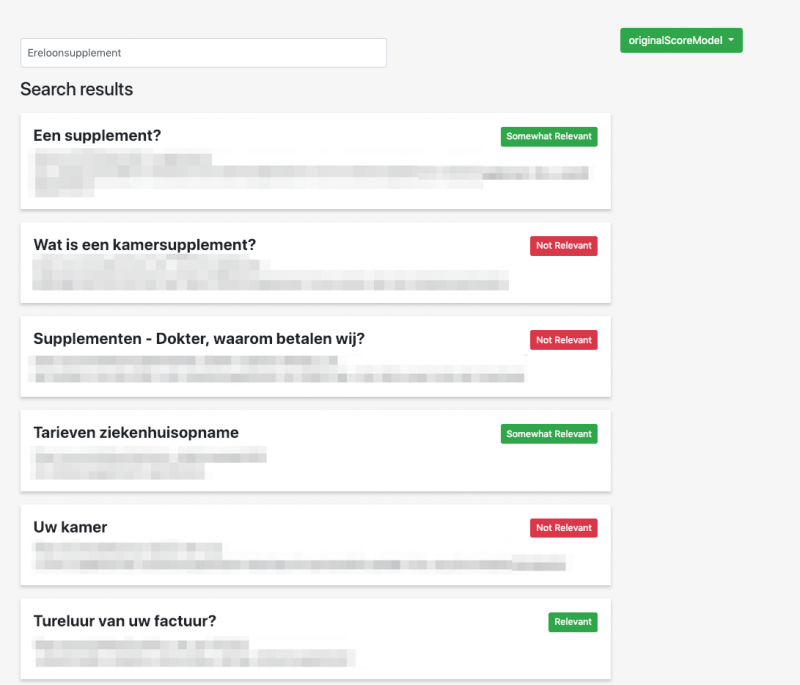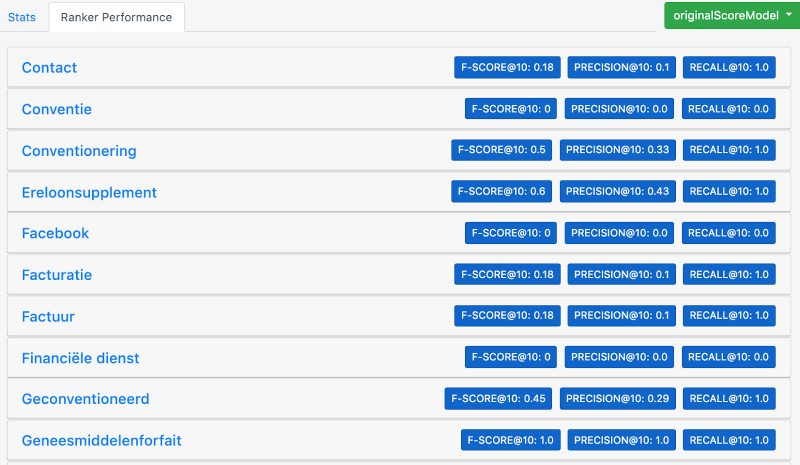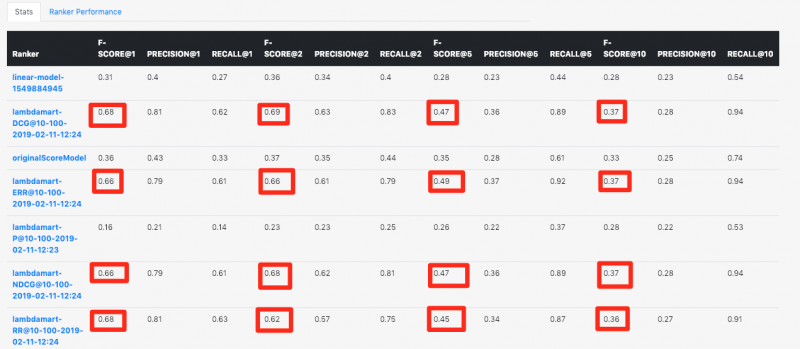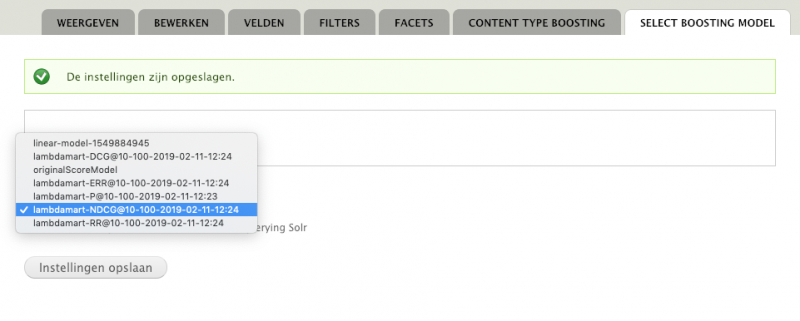Internal search ensures that once people make it to your site, they find precisely what they need. If your internal search isn’t delivering the goods, visitors tend to search elsewhere. In this article, I’ll walk you through the steps we took to refine an on-site search experience to keep our client’s customers happy.
In my upcoming talk at DrupalCon, my colleague Matthias Michaux and I will show you how to improve search results with Drupal machine learning which I’ll show you step-by-step.
DrupalCon: [Machine Learning] Creating more relevant search results with "Learn to Rank". Wed, 28 Oct, 15:00 to 15:40, in the Auditorium.
When Internal Search isn’t working
The irony of having so much great content is that it makes it harder for customers to find exactly what they need. A great on-site search experience can mean the difference between keeping a customer and losing one. When it’s broken, an internal search might cough up an old dusty document and disregard something more recent; or it might give a seeker something broadly popular to most browsers, but not the niche topic they need.
A client came to us with a broken search experience that wasn’t displaying the most relevant content for some of their most important keywords. They’d done their homework and provided us a list of over 150 keywords and the corresponding search results.
Their site was built with Drupal 7 and relied on Search API and Search API Solr for content indexing and content display. We started out with two important troubleshooting steps to make sure everything was plugged in correctly. Apache Solr configurations, and their boosting settings.
First step: Follow Apache Solr Best-Practices for Drupal Search
Since the website was in Dutch, we started by applying our usual best practices for word matching. No instance of Apache Solr search will work properly if the word matching and language understanding haven’t been appropriately configured. For example, if you’re dealing with Apache Solr search in multiple languages, you have to make sure you configure Apache Solr to handle multilingual content correctly.
For this particular website, many of the Apache Solr best practices hadn’t been followed.
- Store rendered output in a single field. You always need to make sure to store the rendered output of your content and additional data (such as meta tags) in one single field in the index. This way, it’s a lot easier to search for all the relevant data. It will make your optimizations easier further down the road and it will render your queries a lot smaller & faster.
- Filter HTML code. Also make sure to filter out any remaining HTML code, as it does not belong in the index.
- Eliminate field label cruft in Drupal. Last but not least, make sure to index this data using as little markup as possible, and get rid of the field labels. You can do this by assigning a specific view mode to each content type. (Drupal 7 View Modes, Drupal 8 View Modes.)
If you’re having trouble with these basics, just get in touch with us so we can give you a hand.
Next step: Improve Search Relevance with Boosting in Apache Solr
Once you’ve improved how content is indexed in Solr, you can make sure visitors are finding the best content. Apache Solr works with relevance scores to determine where a result should be positioned in relation to all of the other results. In search, boosting a page increases the chance it will show up in a search.
With Solr’s boosting functionality you can improve the relevance score of certain factors which change the overall generation of results. The client website that I mentioned earlier, for example, had some custom code written into it to boost the content based on the content type during the time of indexing.
Let’s dig into this a bit deeper.
http://localhost:8983/solr/drupal7/select?
q=ereloonsupplement& // Our term that we are searching for
defType=edismax& // The eDisMax query parser is designed to process simple phrases (without complex syntax) entered by users and to search for individual terms across several fields using different weighting (boosts) based on the significance of each field while supporting the full Lucene syntax.
qf=tm_search_api_aggregation_1^1.0& // Search on an aggregated Search Api field containing all content of a node.
qf=tm_node$title^4.0& // Search on a node title
qf=tm_taxonomy_term$name^4.0& // Search on a term title
fl=id,score& // Return the id & score field
fq=index_id:drupal7_index_terms& // Exclude documents not containing this value
fq=hash:e3lda9& // Exclude documents not containing this value
rows=10& // Return top 10 items
wt=json& // Return it in JSON
debugQuery=true // Show me debugging informationWhen looking at the debugging information, we can see the following:
"e3lda9-drupal7_index_terms-node/10485": "\n13.695355 = max of:\n 13.695355 = weight(tm_search_api_aggregation_1:ereloonsupplement in 469) [SchemaSimilarity], result of:\n 13.695355 = score(doc=469,freq=6.0 = termFreq=6.0\n), product of:\n 6.926904 = idf, computed as log(1 + (docCount - docFreq + 0.5) / (docFreq + 0.5)) from:\n 10.0 = docFreq\n 10702.0 = docCount\n 1.9771249 = tfNorm, computed as (freq * (k1 + 1)) / (freq + k1 * (1 - b + b * fieldLength / avgFieldLength)) from:\n 6.0 = termFreq=6.0\n 1.2 = parameter k1\n 0.75 = parameter b\n 248.69698 = avgFieldLength\n 104.0 = fieldLength\n",This information shows that item scores are calculated based on the boosting of the fields that our system has had to search through. We can further refine it by adding other boost queries such as:
bq={!func}recip(rord(ds_changed),1,1000,1000)This kind of boosting has been around in the Drupal codebase for a very long time and it even dates back to Drupal 6. It is possible to boost documents based on the date they were last updated, so that more recent documents will end up with higher scores.
Did this fix the search experience? Hmm…
We took those steps to make sure Apache Solr was working as we’d expect. Sounds great, right? Not quite for the customer, though!
One of the tricks with boosting is that tweaking the boosting settings in one term is going to impact the results for another. In this case, the client was going back and forth for small changes in boosting overtime, without knowing the effect. Every change developers make to search boosting settings requires a full check on all the other search terms. It’s a constant battle - and it’s a frustrating one. We discovered that even resolving these issues with boosting didn’t fix the problem. The top results in key searches were not the documents they wanted customers to find. In the screenshot, you can see that for this particular query, the most relevant result according to the customer is only ranked as number 7. We’ve had earlier instances where the desired result wouldn’t even be in the top 50!
In comes Machine Learning and Learning To Rank
Learning to rank or machine-learned ranking (MLR) is a method for improving the ranking models by training them as to what is relevant or not.
We quote from the Apache Solr website: “In information retrieval systems, Learning to Rank is used to re-rank the top N retrieved documents using trained machine learning models. The hope is that such sophisticated models can make more nuanced ranking decisions than standard ranking functions like TF-IDF or BM25.” from Apache Solr Docs: Learning to Rank
So to improve the search, we used an in-house application that allows trained human raters from the client’s team to indicate which search results are ‘Not Relevant’, ‘Somewhat Relevant’, ‘Relevant’ or ‘Highly Relevant’, respectively. Human judgment for relevance testing is one way to make sure the best results make their way to the top.
The application sends direct queries to Solr and allows the client to select certain documents that are relevant for the query. Dropsolid adjusted this so that it can properly work with Drupal Search API Solr indexes for Drupal 7 and 8.
We’ve used the application from the screenshot to fill in all the preferred search results when it comes down to search terms. In the background, it translates this to a JSON document that lists the document IDs per keyword and their customer relevance score from 0 to 3, with 3 being the most relevant.
This is a very important step in any optimization process, as it defines a baseline for the tests that we are going to perform.

Footnote: This image is a separate application in Python based on a talk of Sambhav Kothari from Bloomberg Tech at Fosdem.

Using the baseline that we’ve set, we can now calculate how well our original boosting impacts the search results. What we can calculate, as shown in the screenshot above, is the F-Score, the recall & precision of the end result when using our standard scoring model.
Precision is the ratio of correctly predicted positive observations to the total predicted positive observations.
The question that Precision answers is the following: of all results that labeled as relevant, how many actually surfaced to the top? High precision relates to the low false-positive rate.” The higher, the better, with a maximum of 10.
Src: https://blog.exsilio.com/all/accuracy-precision-recall-f1-score-interpretation-of-performance-measures/
Recall is the ratio of correctly predicted positive observations to all observations in the actual class.
The question recall answers is: Of all the relevant results that came back, what is the ratio compared to all documents that were labeled as relevant? The higher the better, with a maximum of 1.
Src: https://blog.exsilio.com/all/accuracy-precision-recall-f1-score-interpretation-of-performance-measures/
If we just look at the top-5 documents, the combined F-Score is 0.35, with a precision of 0.28 and a recall of 0.61. This is quite bad, as only 60% of our relevant documents appear in the top 5 of all search queries. The precision tells us that from the top-5 documents, only 30% has been selected as relevant.
Training our ranking model
Before all of this can work, we have to let Solr know what possible features exist that it might use to decide the importance of each feature based on feedback. An example of such a feature could be the freshness of a node - based on the changed timestamp in Drupal -, or it could just as well be the score of the query against a specific field or data such as meta tags. For reference, I’ve listed them both below:
{
"name":"freshnessNodeChanged",
"class":"org.apache.solr.ltr.feature.SolrFeature",
"params":{
"q":"{!func}recip( ms(NOW,ds_node$changed), 3.16e-11, 1, 1)"
},
"store":"_DEFAULT_"
},
{
"name":"metatagScore",
"class":"org.apache.solr.ltr.feature.SolrFeature",
"params":{
"q":"{!edismax qf=tm_metatag_description qf=tm_metatag_keywords qf=tm_metatag_title}${query}"
},
"store":"_DEFAULT_"
}Using the RankLib library (https://sourceforge.net/p/lemur/wiki/RankLib/), we can train our model and import it into Apache Solr. There are a couple of different models that you can pick to train - for example Linear or Lambdamart - and you can further refine the model to include the number of trees and metrics to optimize for.
You can find more details at https://lucene.apache.org/solr/guide/7_4/learning-to-rank.html
Applying our ranking model
We can, using the rq parameter, apply our newly trained model and re-rank the first 100 results according to the model.
rq={!ltr+efi.query=ereloonsupplement+model=lambdamart-NDCG@10-100-2019-02-11-12:24+reRankDocs=100}If we look at the actual result, it shows us that the search results that we’ve marked as relevant are suddenly surfacing to the top. Our model assessed each property that we defined and it learned from the feedback! Hurray!

We can also compare all the different models. If we just look at the top-5 documents, the combined F-Score of our best performing model is 0.47 (vs 0.35), with a precision of 0.36 (vs 0.28) and a recall of 0.89 (vs 0.61) This is a lot better, as 90% of our relevant documents appear in the top 5 of all search queries. The precision tells us that from the top-5 documents, 36% has been selected as relevant. This is a bit skewed, though, as for some results we only have one highlighted result.
So, to fully compare, I did the calculations it for the first result. With our original model, we only see 46% of our desired results pop up as the first result. With our best-performing model, we improve this score to 79%!
Obviously, we still have some work to do to turn 79% up to 100%, but I would like to stress that this result was achieved without changing a single thing to the client’s content. The remaining few cases are missing keywords in the meta tags of Dutch words that somehow are not processed correctly in Solr.

Of course, we wouldn’t be Dropsolid if we hadn’t integrated this back into Drupal! Are you looking to give back to the community and needing a hand to optimize your search? Give us the opportunity to contribute this back for you - you won’t regret it.

In brief
We started out troubleshooting this perplexing search problem by making sure we had the essential configurations in the right place. When that didn’t fix things, we turned to machine learning in Drupal search.
We compiled a learning dataset, we trained our model and uploaded the result to Apache Solr. Next, we used this model during our queries to re-rank the last 100 results based on the trained model. It is still important to have a good data model, which means getting all the basics on Search covered first.
Need help with optimizing your Drupal 7 or Drupal 8 site search? Contact us.
If you’re coming to DrupalCon, join myself and my colleague Matthias Michaux for an in-depth look at machine learning and Drupal search.
DrupalCon: [Machine Learning] Creating more relevant search results with "Learn to Rank" Wed, 30 Oct, 16:15 to 16:55, in the Auditorium